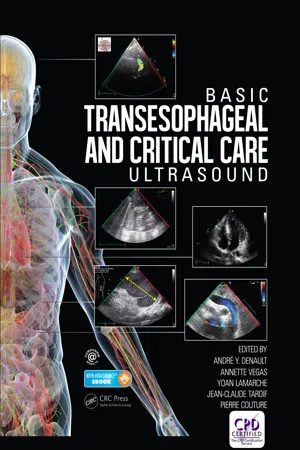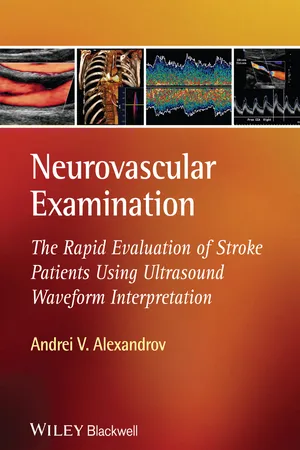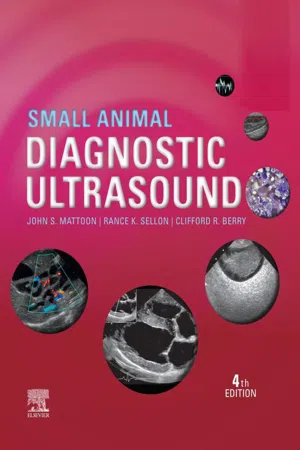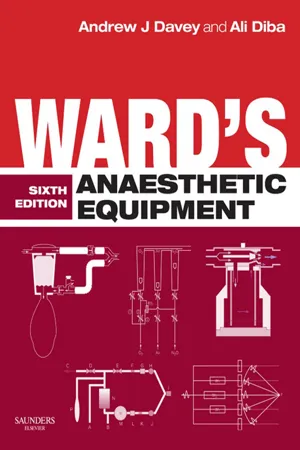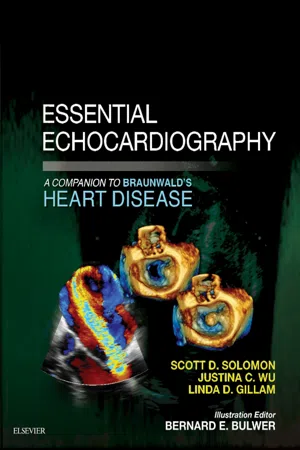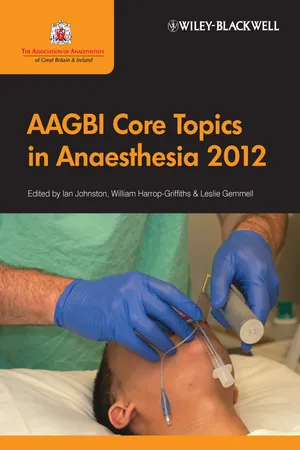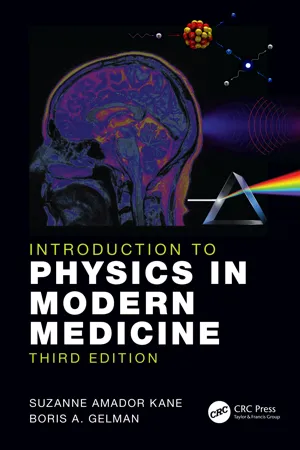Physics
Ultrasound
Ultrasound refers to sound waves with frequencies higher than the upper audible limit of human hearing. In physics, ultrasound is used for various applications, including medical imaging, industrial testing, and cleaning. It works by emitting high-frequency sound waves and analyzing the echoes that bounce back, allowing for non-invasive imaging and measurements.
Written by Perlego with AI-assistance
Related key terms
Related key terms
1 of 4
Related key terms
1 of 3
12 Key excerpts on "Ultrasound"
- eBook - ePub
- Asim Kurjak(Author)
- 2020(Publication Date)
- CRC Press(Publisher)
Chapter 1BASIC PHYSICS OF Ultrasound
Branko Breyer
TABLE OF CONTENTSI. Introduction II. Physical Principles A. Ultrasound Waves B. Ultrasound Propagation in Tissues 1. Refraction and Reflection of Ultrasound Waves III. Echoscopic Systems A. Main Blocks of an Echoscope B. Transducer and the Ultrasound Beam C. Echoscope Probes and Scanning Systems D. Attenuation Compensation: TGC E. Dynamic Range F. Some Notes on Resolution and Practical Use G. Looking at the Image, Artifacts IV. Doppler Effect and Its Use V. Some Practical Advice ReferencesI. INTRODUCTION
In this chapter, we describe the basic physical and technological principles of Ultrasound diagnostics without mathematical treatment, except for some simple formulas, yet include comments relevant for practical use. Ultrasound diagnostic instruments and procedures are still in fast development, so that mere knowledge of manipulation with the existing instruments is definitely insufficient for sound usage of the existing instruments to come in a few years. The knowledge of underlying principles allows one to understand what is actually new in an instrument, and what are the supposed advantages.II. PHYSICAL PRINCIPLES
A. Ultrasound Waves
Ultrasound is, per definition, the sound of a frequency higher than the hearing limit of the human ear, i.e., above 16 to 20 kHz. Bat’s definition of Ultrasound would be different. In medical diagnostics, one normally uses Ultrasound waves of frequencies between 2 and 10 MHz. Basic physical principles are equally valid for audible sound as for Ultrasound, only at different scales. Ultrasound is a mechanical wave, i.e., it consists of mechanical vibrations of medium particles through which it propagates. In soft tissues, the medium particles vibrate along the direction of wave propagation creating their densifications and rarefactions in space. Such a wave is called a longitudinal wave. The particles (molecules) oscillate around their (stochastic) balance positions with no net flow of matter, however, the energy flows. At very high energy densities some net flow can be induced, but this does not apply to energies of Ultrasound used in diagnostics. Other types of waves like transversal and Raileigh cannot propagate to any appreciable distance in soft tissues. Ultrasound waves are characterized by parameters like frequency, wavelength, propagation speed, intensity, and pressure. Frequency is expressed in hertz (Hz), i.e., cycles per second. The physical dimension is 1/s; 1 Hz = 1 c/s, 1 kHz = 1000 c/s, and 1 MHz = 1 million c/s. The frequency used in diagnostics largely influences their properties. Wavelength is the distance between the same phases of compression of the medium in two consecutive cycles in space and is measured in meters or its subunits like millimeters. The propagation speed depends mainly on the media (tissue) properties through which the wave propagates and is related with frequency and wavelength as follows: - eBook - ePub
- Ehsan Samei, Donald J. Peck(Authors)
- 2019(Publication Date)
- Wiley-Blackwell(Publisher)
9 UltrasonographyCHAPTER MENU
- 9.1 Introduction
- 9.2 Sound Properties
- 9.3 Transducers
- 9.4 Ultrasound Beam
- 9.5 Ultrasound Imaging
- 9.6 Doppler
- 9.7 Artifacts
- 9.8 Therapeutic Use and Bioeffects
- References
9.1 Introduction
Ultrasonography, or Ultrasound in short, is an imaging modality that exploits the acoustical properties of the human tissue in conjunction with an ultrasonic energy source and receptor to characterize the boundaries of tissues and movements within the human body. This modality is one of two main medical imaging modalities, along with magnetic resonance imaging (MRI), that does not use ionizing radiation. However, a source of energy is still employed, and the body's response to the energy is the foundation of image formation. The most common mode of ultrasonic imaging is through echo location, where the timing of the reflection of ultrasonic waves from the body structures forms the imaging signal. Ultrasound has a depth of penetration in the body in the multicentimeter range (dependent on the wave frequency) and is limited in areas with air or bone, limiting its reach and application. However, given its safety, low cost, and quantitative attribute, its use in obstetrics/gynecology and cardiac care has become ubiquitous, making it an essential component of quality care.9.2 Sound Properties
Sound is a mechanical disturbance from a state of equilibrium that propagates through an elastic material or medium. An elastic material is a collection of molecules that are in continuous random motion. When no external force is applied to the material, the molecules are distributed uniformly. When a force is applied to the material, each molecule of the material will become closer to the molecules immediately adjacent to it. As the molecules are pressed together, there is an increased pressure at that location; the region of increased pressure is termed a zone of compression. The increased pressure is not at equilibrium, and therefore, the molecules in the zone of compression exert a force on the neighboring molecules to return to equilibrium. This force produces a new zone of compression, and this process propagates through the material. That is, a mechanical disturbance introduced into the material (e.g. compression of spacing between molecules) will travel through the material in a direction away from the source of the disturbance. When a zone of compression migrates through a material, the molecules that surround it will move into this region to restore it to its normal particle density. This creates a second region where the particle density is reduced compared to equilibrium, termed a zone of rarefaction. Thus, the compression zone (high density of molecules) is followed by a rarefaction zone (low density of molecules). - eBook - ePub
Ultrasound in Food Processing
Recent Advances
- Mar Villamiel, José V. García-Pérez, Antonia Montilla, Juan A. Carcel, Jose Benedito, Mar Villamiel, José V. García-Pérez, Antonia Montilla, Juan A. Carcel, Jose Benedito(Authors)
- 2017(Publication Date)
- Wiley-Blackwell(Publisher)
Part 1 Fundamentals of UltrasoundPassage contains an image
1 Basic Principles of Ultrasound
Juan A. Gallego‐Juárez1,21 Instituto de Tecnologías Físicas y de la Información (ITEFI), Consejo Superior de Investigaciones Científicas (CSIC), Madrid, Spain2 PUSONICS S. L, Arganda del Rey (Madrid), Spain- 1.1 Introduction
- 1.2 Generation and Detection of Ultrasonic Waves: Basic Transducer Types
- 1.3 Basic Principles of Ultrasonic Wave Propagation
- 1.4 Basic Principles of Ultrasound Applications
- 1.4.1 Low‐intensity Applications
- 1.4.1.1 Non‐destructive Testing of Materials
- 1.4.1.2 Ultrasonic Imaging
- 1.4.1.3 Process Control
- 1.4.2 High‐intensity Effects and Applications: Power Ultrasound
- 1.4.2.1 Cleaning
- 1.4.2.2 Atomization
- 1.4.2.3 Mixing, Homogenization, and Emulsification
- 1.4.2.4 Defoaming
- 1.4.2.5 Drying and Dewatering
- 1.4.2.6 Supercritical Fluid Extraction Assisted by Ultrasound
- 1.4.2.7 Bioremediation
- 1.4.2.8 Particle Agglomeration
- 1.4.2.9 Sonochemical Processes
- 1.4.1 Low‐intensity Applications
- 1.5 Conclusions
- Acknowledgments
- References
1.1 Introduction
As is well known, acoustics is the science of elastic waves, a broad interdisciplinary field which comprises such diverse areas as life and earth sciences, engineering, and arts. It may be divided into three main branches according to the frequency spectrum and the hearing characteristics to which the human auditory system responds: infrasound, sound, and Ultrasound.Infrasound is the branch dealing with frequencies below the human hearing range (0–20 Hz), sound refers to the human audible range (20Hz–20kHz), and Ultrasound covers the very wide range of elastic waves from 20 kHz up to the frequencies associated to wavelengths comparable to intermolecular distances (about 1012 - André Denault, Annette Vegas, Yoan Lamarche, Jean-Claude Tardif, Pierre Couture, André Denault, Annette Vegas, Yoan Lamarche, Jean-Claude Tardif, Pierre Couture(Authors)
- 2017(Publication Date)
- CRC Press(Publisher)
Chapter 1Wilfredo Puentes and Annette VegasUltrasound Imaging: Acquisition and Optimization
INTRODUCTION
This chapter presents a brief description of the basic physical principles of Ultrasound (US), as well as the steps involved in producing an Ultrasound image. Common US probes and key controls on the US machine for acquiring and optimizing the different imaging modes (two-dimensional (2D) and Doppler) are outlined.BASIC PRINCIPLES OF Ultrasound
Sonography comes from the Latin sonus (meaning “sound”) and the Greek word graphien (meaning “to write”). Medical ultrasonography uses high frequency sound waves to create images. To appreciate how this process occurs, it is important to understand some of the concepts related to sound.Sound Waves
Sound is mechanical energy transmitted as longitudinal pressure waves formed by molecular interaction in a medium, and hence cannot occur in a vacuum. As sound waves travel through a medium, each molecule hits another and returns to its original position, creating more dense (compression) and less dense (rarefaction) regions in the medium. Different properties of the sound wave can be described including: cycle, frequency, period, wavelength, amplitude, power, intensity, and propagation speed (Figure 1.1 ).A cycle comprises one rarefaction and one compression of the sound wave. Frequency (f) is the number of cycles in a given time, 1 cycle/second = 1 Hertz (Hz). Period (T) is the time it takes for one complete cycle to pass a point or for a wave to travel a distance of one wavelength. Wavelength (λ) represents the horizontal distance between any two successive equivalent points on the wave or the length of one cycle of the wave. Frequency and period are inversely proportional (f = 1/T), thus a higher frequency has a shorter wavelength and period. For instance, a higher frequency probe, such as a transesophageal echocardiography (TEE) probe, is superior to a transthoracic echocardiography (TTE) probe in detecting endocarditis because small vegetations can be missed with TTE. The TTE probe has a lower frequency and consequently a larger and less precise wavelength.- eBook - ePub
- B.H Brown, R.H Smallwood, D.C. Barber, P.V Lawford, D.R Hose(Authors)
- 2017(Publication Date)
- CRC Press(Publisher)
Chapter 7Ultrasound
7.1 Introduction and Objectives
This chapter is concerned mainly with the basic physics of Ultrasound, but it also provides background material for several different areas. The propagation of pressure waves through different media underlies audiology, Ultrasound techniques and, to a lesser extent, blood pressure measurement.We will consider some of the physics of the generation and propagation of Ultrasound in tissue. A description of the practical implementations of Ultrasound imaging is given in Chapter 12 (section 12.3). Use of Doppler-shifted Ultrasound for blood flow measurement is described in Chapter 19 (section 19.7).Some of the questions which we will address are:- Is sound a transverse or longitudinal vibration?
- Is energy transmitted within a sound wave?
- Why does inhaling helium make the pitch of a voice rise?
- Under what circumstances is sound refracted and reflected in the same way as light?
- Can we actually produce simple sound field patterns?
- How big should an Ultrasound transducer be?
Ultrasound is sound which is at too high a pitch for the human ear to detect. It is widely used in medical diagnosis because it is non-invasive, and there are no known harmful effects at the power levels that are currently used. It is most commonly used in the same way that bats use Ultrasound for locating obstacles when flying at night. The bat transmits a short burst of Ultrasound and listens for the echo from surrounding objects. The time taken for the echo to return is a measure of the distance to the obstacle. If the Ultrasound is transmitted into the body, the interfaces between the different structures in the body will produce echoes at different times. A display of echo size against time (an A scan) gives information about the position of the structures. This is used, for instance, to locate the mid-line of the brain. If the position and orientation of the transmitter and receiver are known, and the echoes are used to intensity modulate a display, a two-dimensional map of the structures within the body can be obtained. This is a B scan - eBook - ePub
Neurovascular Examination
The Rapid Evaluation of Stroke Patients Using Ultrasound Waveform Interpretation
- Andrei V. Alexandrov(Author)
- 2013(Publication Date)
- Wiley-Blackwell(Publisher)
4 Applied Principles of Ultrasound Physics“The only test I failed in my whole medical career was that on Ultrasound physics.” Frequent comment by Ultrasound technology examineesIntroduction
When I was at school, I dreamed of being a physicist. My physics teacher mesmerized me by explaining how Nature works. However, it was my junior school classmate and friend, Vladimir Voevodsky, a brilliant math wizard and now at the Institute for Advanced Study in Princeton, NJ, whose extraordinary abilities across the sciences made me realize early on that physics is beyond my limits. Physics remained the area to listen, learn, absorb, and try to understand how Nature works. So humbled, I decided to become a physician. This chapter provides a simplistic introduction for clinicians to a much broader and evolving knowledge about Ultrasound, a small fraction of which is used in cerebrovascular imaging.By definition, waves are cyclic events that consist of pressure ups and downs that compress and relax the medium, supposedly leaving particles at the end of a cycle in the exact same location. Yet, when sound as a mechanical pressure wave propagates though a human body, many factors come into play and the wave eventually attenuates due to absorption and dispersion. Does the wave sent on a straight course always stay that way? Changes in direction can occur, as will be described later in this chapter. Because attenuation occurs as the wave propagates, is the energy being transformed into heat or could it interact with tissues in other potentially harmful ways? Thermal and nonthermal bioeffects are indeed of concern and regulations apply to limit emitted Ultrasound power.For a clinician set to use Ultrasound, it is important to understand the very basic principles of applied physics to explain, if need be, how a simple diagnostic Ultrasound test works and why it is safe. For a scientist, examination of the human body with Ultrasound offers a puzzle comparable in possibilities to a chess game or an exploration of our universe in terms of myriad of objects scattered yet interconnected across the continuum. - eBook - ePub
- John S. Mattoon, Rance K. Sellon, Clifford Rudd Berry(Authors)
- 2020(Publication Date)
- Saunders(Publisher)
5 These textbooks uniformly stress that image quality depends on knowledge of the interaction of sound with tissue and the skillful use of the scanner’s controls. Ultrasound examinations are highly interactive; a great deal of flexibility is often required for good images to be obtained. Accurate interpretation depends directly on the differentiation of normal and abnormal anatomy. Unlike with other imaging modalities, interpretation is best made at the time of the study. It is very difficult to render a meaningful interpretation from another sonographer’s static images or video clips.Basic acoustic principles
Wavelength and frequency
Sound results from mechanical energy propagating through matter as a pressure wave, producing alternating compression and rarefaction bands of molecules within the conducting medium (Fig. 1.1 ). The distance between each band of compression or rarefaction is the sound’s wavelength (λ), the distance traveled during one cycle. Frequency is the number of times a wavelength is repeated (cycles) per second and is expressed in hertz (Hz). One cycle per second is 1 Hz; 1000 and 1 million cycles per second are 1 kilohertz (kHz) and 1 megahertz (MHz), respectively. The range of human hearing is approximately 20 to 20,000 Hz. Diagnostic Ultrasound is characterized by sound waves with a frequency up to 1000 times higher than this range. Sound frequencies in the range of 2 to 15 MHz and higher are commonly used in diagnostic Ultrasound examinations. Even higher frequencies (20 to 100 MHz) are used in special ocular, dermatologic, and microimaging applications.Fig. 1.1 Ultrasound waves and echoes. A, Ultrasound emitted from the transducer is produced in longitudinal waves consisting of areas of compression (C) and rarefaction (R). B, The wavelength, depicted overlying the longitudinal wave, is the distance traveled during one cycle. Frequency is the number of times a wave is repeated (cycles) per second. The wavelength decreases as frequency increases. Switching from a lower frequency to a higher frequency transducer (e.g., from 3.0 to 7.5 MHz) shortens the wavelength and provides better resolution. C, In pulsed Ultrasound systems, sound is emitted in pulses of two or three wavelengths rather than continuously as seen in A and B - eBook - ePub
Ward's Anaesthetic Equipment
Ward's Anaesthetic Equipment E-Book
- Andrew J Davey, Ali Diba(Authors)
- 2012(Publication Date)
- Saunders(Publisher)
Chapter 31 Physics and technology of Ultrasound Crispian Oates Chapter contents What is Ultrasound? With the advent of low-cost portable scanning equipment, Ultrasound has now become an important tool in the armoury of the anaesthetist. Such machines are becoming ever more sophisticated as functions once seen only on large, high-end equipment are migrating down to the entry level systems. In order to be able to use Ultrasound equipment and interpret the images produced effectively and safely, it is important to understand some of the basic physical principles behind Ultrasound as an imaging modality. This chapter has been included to cover that essential ground and to assist the practitioner to proficiently use Ultrasound equipment and interpret what is seen. What is Ultrasound? Diagnostic Ultrasound uses high-frequency sound waves sent into the body, to build up an image of the anatomical structures within from the detected echoes. A sound wave is what is known as a longitudinal compression wave (Fig. 31.1). It may be formed by some sort of piston, a loudspeaker for example, that pushes forward onto the molecules of air in front of it forming a region of higher density and pressure immediately in front of the piston. These molecules then push on to the molecules in front of them and so on, so the pulse of high pressure starts to move forward away from the piston. Meanwhile the piston moves backwards creating a region of low density and pressure in the molecules in front of it. By repeatedly moving forwards and backwards, a succession of high pressure followed by low-pressure regions move away from the piston forming a longitudinal pressure wave, a sound wave. If we were able to see just one molecule in front of the piston, we would see it oscillate forwards and backwards about an average position, like a child on a swing. Hence the molecules of the medium carrying the sound wave stay in approximately the same place, but the disturbance, i.e - Asim Kurjak(Author)
- 2019(Publication Date)
- CRC Press(Publisher)
Chapter 1 BASIC PRINCIPLES OF ULTRASONIC IMAGING Branko Breyer and Željko Andreić INTRODUCTIONIn this chapter we shall describe basic physical and technological principles of Ultrasound diagnostic equipment without extensive mathematical treatment, except for some simple and useful formulas. These formulas are usually supported by worked examples and comments relevant for practical use. Ultrasound diagnostic instruments and procedures are developing rapidly, so that mere knowledge of manipulation with the existing instruments is definitely insufficient for sound usage of the instruments to come. On the other hand, the knowledge of underlying physical principles allows one to understand what is actually new in an instrument, what the supposed advantages are, and how they can be exploited in practical work.PHYSICAL PRINCIPLES BASIC CONCEPTS OF WAVES AND SOUNDSound is mechanical vibration which spreads from its source into the surrounding medium. Such spreading mechanical vibrations are called waves, mostly because in many ways they resemble waves on the water surface. For instance, if we disturb calm water, say, with a wooden stick which we move up and down, water waves will form and spread radially away from the stick. In an analogous way, sound waves are produced by disturbing the air somehow, and they spread in all directions away from their source. When we speak about sound waves, we intuitively think about audible sound which we can hear and which spreads in air. Sound waves can also exist in other media and can be totally imperceptible to us. What is common to all “sound” waves is that they can be described by the same laws of nature.The vibrating object which produces the sound is called the source. This source is somehow made to vibrate, and its vibrations disturb the medium around it. The produced disturbances spread away through the medium around the source in the same way the water waves spread around the moving stick. If we look at the water waves more carefully, we will see that the water itself does not flow. It just moves up and down, and the movements travel from the stick outwards. This can be verified by a simple experiment. If we put a few small chips of wood on the water surface and watch their movements as the wave passes by, we can see the chips moving up and down while the wave is passing by them, but after the wave is gone, they are again at rest at their original positions. So, only the disturbance travels through the water, while water itself stays at rest. This traveling disturbance is called a wave, and under normal circumstances it produces no flow of medium through which it spreads. In audible sound waves, air molecules are moved back and forth around their positions in the direction of wave spreading. Such a wave is called a longitudinal wave. All sound waves in normal circumstances are longitudinal. In some cases, transversal waves or waves with complicated particle motions can exist, but we shall limit our discussion only to the longitudinal sound waves because only such waves are used for therapeutic and diagnostic applications.- Scott D Solomon, Justina Wu, Linda D. Gillam(Authors)
- 2017(Publication Date)
- Elsevier(Publisher)
Ultrasound .The principal determinants of the Ultrasound wave are: (1) wavelength (λ), which represents the spatial distance between two compressions (and is the primary determinant of axial resolution, as defined later), (2) frequency (f), which is inversely related to wavelength, and (3) velocity of sound (c), which is a constant for any given medium (Fig. 1.1A and B ).These three wave characteristics have a set relationship as c = λf. An increase in the frequency (i.e., shortening of the wavelength) implies less deep penetration due to greater viscous effects leading to more attenuation. As the acoustic wave travels through tissue, changes in tissue properties, such as tissue density, will induce disruption of the propagating wave, leading to partial reflection (specular reflections) and scatter (backscatter) of its energy (Fig. 1.2 , Box 1.1 ).4 Typically, specular reflections originate from interfaces of different types of tissue (such as blood pool and myocardium or myocardium and pericardium), whereas backscatter originates from within a tissue, such as myocardial walls. In both cases, reflections propagate backwards to a piezoelectric crystal, again leading to its deformation, which generates an electric signal. The amplitude of this signal (termed the radiofrequency [RF] signal ) is proportional to the amount of deformation of the crystal (i.e., the amplitude of the reflected wave). This signal is then amplified electronically, which can be modified by the “gain” settings of the system that will amplify both signal and noise. In addition to defining the amplitude of the returning signal, the depth of the reflecting structure can be defined according to the time interval from emitting to receiving a pulse, which equals the time required for the Ultrasound to travel from the transducer to the tissue and back. The data on amplitude and depth of reflection are used to form scan lines , and the overall image construction is based on repetitive operations of the previously mentioned procedures of image (scan line) acquisition and (post-) processing. During image acquisition, transducers emit Ultrasound waves in pulses of a certain duration (pulse length), at a certain rate, termed the pulse repetition frequency (PRF), which is one of the determinants of the temporal resolution of an echo image (obviously limited by the duration of the pulse-echo measurement [i.e., its determinants]), as elucidated further (see Fig. 1.1C- eBook - ePub
- Ian Johnston, William Harrop-Griffiths, Leslie Gemmell, Ian Johnston, Leslie Gemmell, William Harrop-Griffiths(Authors)
- 2011(Publication Date)
- Wiley-Blackwell(Publisher)
CHAPTER 1
The Physics of Ultrasound Graham Arthurs Maelor Hospital, Wrexham, UKKey points- Ultrasound is a high-frequency pressure energy wave transmitted longitudinally through the soft tissues of the body.
- Advances in computer technology have made medical Ultrasound possible by processing millions of signals every second.
- Ultrasound makes it possible to examine most of the tissues of the body safely and easily.
- The pressure, energy and heating effects of clinical Ultrasound devices have not been shown to damage normal biological tissues.
- The Ultrasound wave must be reflected off a tissue interface at right angles. This means that a combination of good hand–eye coordination and correct positioning of the probe is the basis of a good image.
- Images are presented as patterns on a greyscale monitor. Pattern recognition is therefore the basis of the interpretation of these images.
- The B or brightness mode gives a greyscale image that is distorted because of a loss of reflected echoes by scatter and refraction.
- Doppler shift is caused by a change in wavelength when fluid such as blood is moving towards or away from the Ultrasound wave.
This chapter aims to give an introduction to the basic physics of Ultrasound in order to allow the reader to understand how images are produced and hence how to obtain the best images when using Ultrasound. Clinical Ultrasound devices simultaneously produce and transmit multiple pressure waves, and receive and rapidly interpret the many attenuated, returning pressure wave signals. The pressure wave signals are converted into electrical signals. The production of an image in real time by a portable scanner has only become possible with the development of the microprocessor chip. A modern Ultrasound device has a lot of computing power with many microprocessors performing many billion operations per second, which makes it possible to build up complicated images in real time. In the near future, smaller processors will enable more precise images to be created on smaller, lighter and cheaper devices. - eBook - ePub
- Suzanne Amador Kane, Boris A. Gelman(Authors)
- 2020(Publication Date)
- CRC Press(Publisher)
(Note that these are very small values compared to those used in laser surgery, as explained in Chapter 3. For comparison, a typical conversation at arm’s length corresponds to an intensity of 3 × 10 − 10 watts/cm 2, while long-term exposure to audible sounds with intensities over 10 − 4 watts/cm 2 can damage the human ear. Since the ear does not respond to Ultrasound waves, Ultrasound intensities used for imaging are not detected by the human ear and do not damage that organ.) These numbers are only averages. However, during pulses, the intensity can be much higher. On the other hand, the inevitable absorption and spreading of the sound waves causes the intensity to vary, and in general diminish, as the pulses travel into the body. Researchers have conducted extensive safety studies, discussed in Section 4.11, to establish that the absorption of relatively intense Ultrasound by the body does not result in enough energy being absorbed to cause harm. 4.10 Ultrasound Image Quality and Artifacts Many effects can distort the image formed by a diagnostic Ultrasound instrument, leading to poor spatial resolution or even images of nonexistent structures. Fortunately, many of these distortions and artifacts can be explained, or avoided, by understanding more about how sound waves travel through tissue. The attenuation of sound waves as they travel through the body results in echoes with decreasing intensity with increasing depth. To offset this, Ultrasound scanners compensate for attenuation by a fixed formula that increases the brightness of images with distance using the half-intensity depth relationship (Equation 4.10). However, this means that any deviation from the expected absorption will introduce errors in brightness. This can result in a very absorbing (or very reflective) region effectively preventing the Ultrasound pulses from traveling farther into the body, creating a dark region (an acoustic shadow) where no reflections were detected
Index pages curate the most relevant extracts from our library of academic textbooks. They’ve been created using an in-house natural language model (NLM), each adding context and meaning to key research topics.
Explore more topic indexes
Explore more topic indexes
1 of 6
Explore more topic indexes
1 of 4



